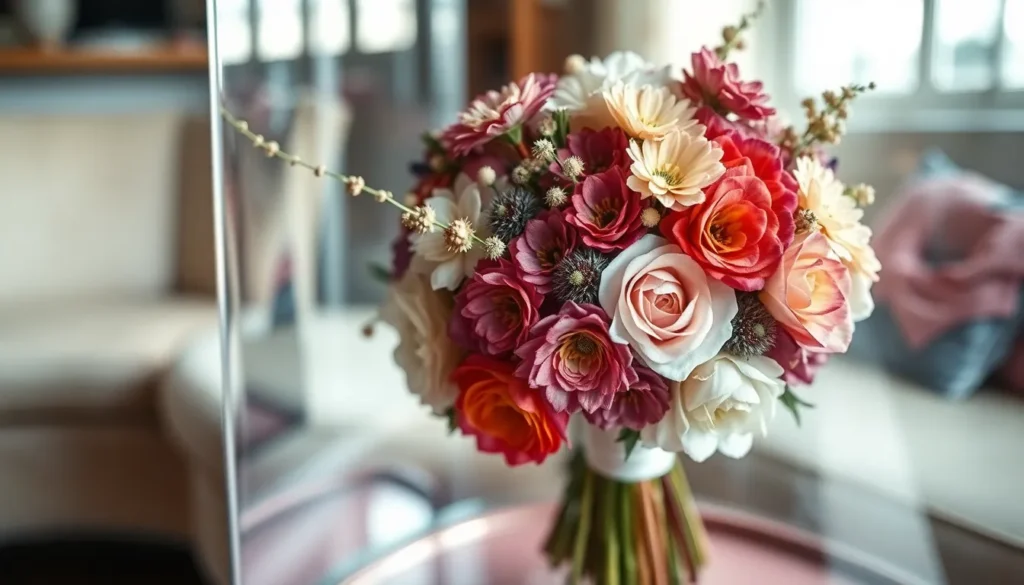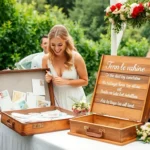Your wedding bouquet represents one of the most meaningful moments of your special day and we understand why you’d want to preserve those precious blooms forever. After months of planning and choosing the perfect flowers that complement your vision you shouldn’t have to watch them wilt and fade into memory.
We’ve discovered countless creative ways to transform your wedding flowers into lasting keepsakes that’ll bring back those magical moments every time you see them. From traditional pressing techniques to modern resin art and innovative freeze-drying methods there’s a preservation option that matches every bride’s style and budget.
The best part? Many of these preservation methods are surprisingly simple and can be started right after your ceremony. Whether you’re looking for elegant wall art romantic jewelry or unique home décor pieces we’ll guide you through the most effective techniques to capture your wedding day beauty for years to come.
Press Your Wedding Flowers Into Timeless Keepsakes
Pressing your wedding flowers transforms delicate blooms into lasting treasures that capture your special day. This classic preservation method offers a gentle way to create beautiful keepsakes while maintaining the natural charm of your bouquet.
Traditional Flower Pressing Techniques
Select fresh flowers immediately after your ceremony for the best pressing results. We recommend choosing blooms that are at their peak freshness, avoiding any that show signs of wilting or browning. Flat flowers like pansies, violets, and small roses work exceptionally well for traditional pressing.
Prepare your pressing materials by gathering heavy books, absorbent paper, and cardboard pieces. Place a sheet of parchment paper or wax paper between the pages of thick books like phone directories or encyclopedias. This prevents moisture from damaging the book pages during the pressing process.
Arrange flowers carefully on the absorbent paper, ensuring petals don’t overlap. We suggest pressing similar flowers together and keeping a record of which flowers you’ve placed in each location. The pressing process typically takes 2-4 weeks, depending on the flower type and thickness.
Apply consistent pressure by stacking additional heavy books on top of your pressing setup. Change the absorbent paper after the first week to prevent mold growth and ensure proper drying. This traditional method costs virtually nothing and produces beautifully flat specimens perfect for crafting.
Modern Microwave Pressing Methods
Speed up the pressing process using microwave flower presses that complete the job in minutes rather than weeks. These specialized tools consist of two wooden boards with foam padding and straps that apply even pressure during heating. Most microwave presses handle 4-6 flowers at once.
Prepare flowers for microwaving by removing excess moisture with a paper towel. Place blooms between the press layers, ensuring they lie completely flat without any folded petals. We recommend starting with less delicate flowers like daisies or small roses to perfect your technique.
Follow exact timing guidelines based on your microwave’s wattage and flower type. Most flowers require 30-60 seconds on medium power, but thicker blooms may need up to 2 minutes. Allow the press to cool for 10 minutes between sessions to prevent overheating.
Check results carefully after each pressing session, as over-microwaving can make flowers brittle or brown. We’ve found that multiple short sessions work better than one long session for preserving color and texture. This method works best for flowers with lower moisture content.
Creating Pressed Flower Art and Frames
Design your pressed flower display by sketching layouts before permanently arranging flowers on your chosen background. We suggest using acid-free paper or fabric as your base to prevent yellowing over time. Consider creating shadow boxes, picture frames, or decorative cards with your preserved blooms.
Secure flowers permanently using small dots of create glue or double-sided tape. Apply adhesive sparingly to avoid visible marks that could detract from the natural beauty of your pressed flowers. Work in a dust-free environment to prevent particles from settling on your delicate specimens.
Protect your finished artwork with UV-resistant glass or acrylic covers that prevent fading. Frame your pressed flower art using archival matting materials that won’t yellow or deteriorate over time. We recommend keeping framed pieces away from direct sunlight and humid areas.
Create multiple keepsakes from a single bouquet by designing various sized pieces for different rooms in your home. Consider making bookmarks, greeting cards, or small wall hangings as gifts for wedding party members. This approach maximizes the impact of your preserved flowers while sharing memories with loved ones.
Dry Your Bridal Bouquet Using Air-Drying Methods
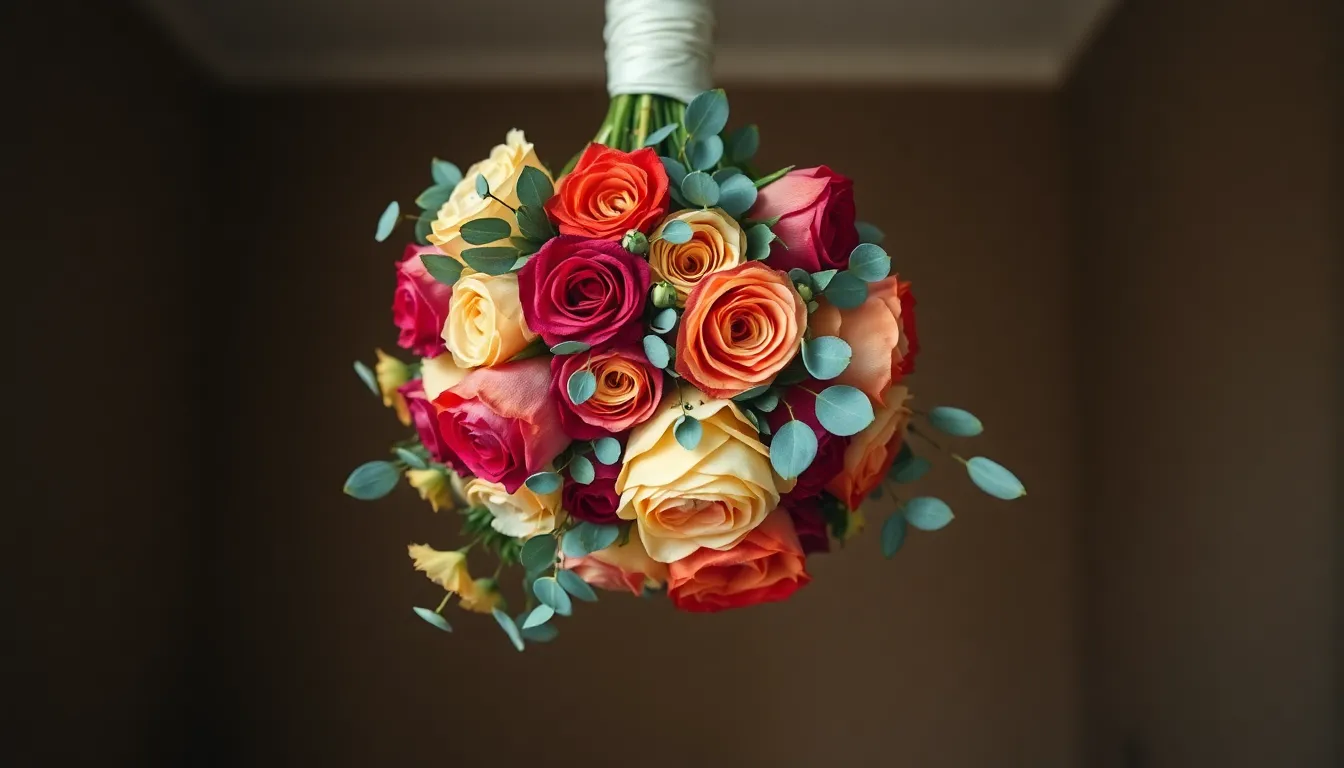
Air-drying methods offer simple yet effective ways to preserve your wedding flowers without specialized equipment. These traditional techniques allow you to transform your bridal bouquet into lasting keepsakes using materials you likely have at home.
Hanging Upside Down Preservation
Hanging your bouquet upside down creates a natural drying environment that preserves flower structure beautifully. Strip excess leaves from stems and secure the bouquet with string or rubber bands before hanging it in a warm, dry location away from direct sunlight.
Choose areas like attics, closets, or spare rooms where humidity stays low and air circulation remains consistent. The complete drying process typically takes several weeks, but patience rewards you with flowers that maintain their natural appearance and form.
Monitor your bouquet weekly to ensure proper drying progress and prevent mold development. Flowers like roses, baby’s breath, and eucalyptus respond exceptionally well to this method, retaining much of their original beauty once fully dried.
Silica Gel Drying Process
Silica gel provides faster results than traditional air-drying while maintaining excellent color retention. Purchase food-grade silica gel crystals from create stores and place them in an airtight container large enough to accommodate your flowers without crushing delicate petals.
Bury individual blooms completely in the silica gel, ensuring crystals surround each flower entirely. Roses and peonies work particularly well with this method since they can tolerate the gentle pressure from the drying agent.
Seal the container and wait approximately one week for complete moisture absorption. Remove flowers carefully with tweezers and brush away any remaining crystals with a soft paintbrush before displaying your preserved blooms.
Glycerin Treatment for Lasting Color
Glycerin treatment maintains flower flexibility and vibrant colors longer than other air-drying methods. Mix one part glycerin with two parts warm water in a tall vase or container deep enough to submerge flower stems completely.
Cut stems at an angle under running water and immediately place them in the glycerin solution. Fresh flowers absorb the mixture best, so begin this process within hours of your ceremony for optimal results.
Allow stems to soak for several days until petals feel supple and slightly waxy to the touch. This preservation method works exceptionally well for foliage like eucalyptus and ferns, maintaining their natural movement and preventing brittleness that occurs with other drying techniques.
Freeze-Dry Your Wedding Flowers for Perfect Preservation
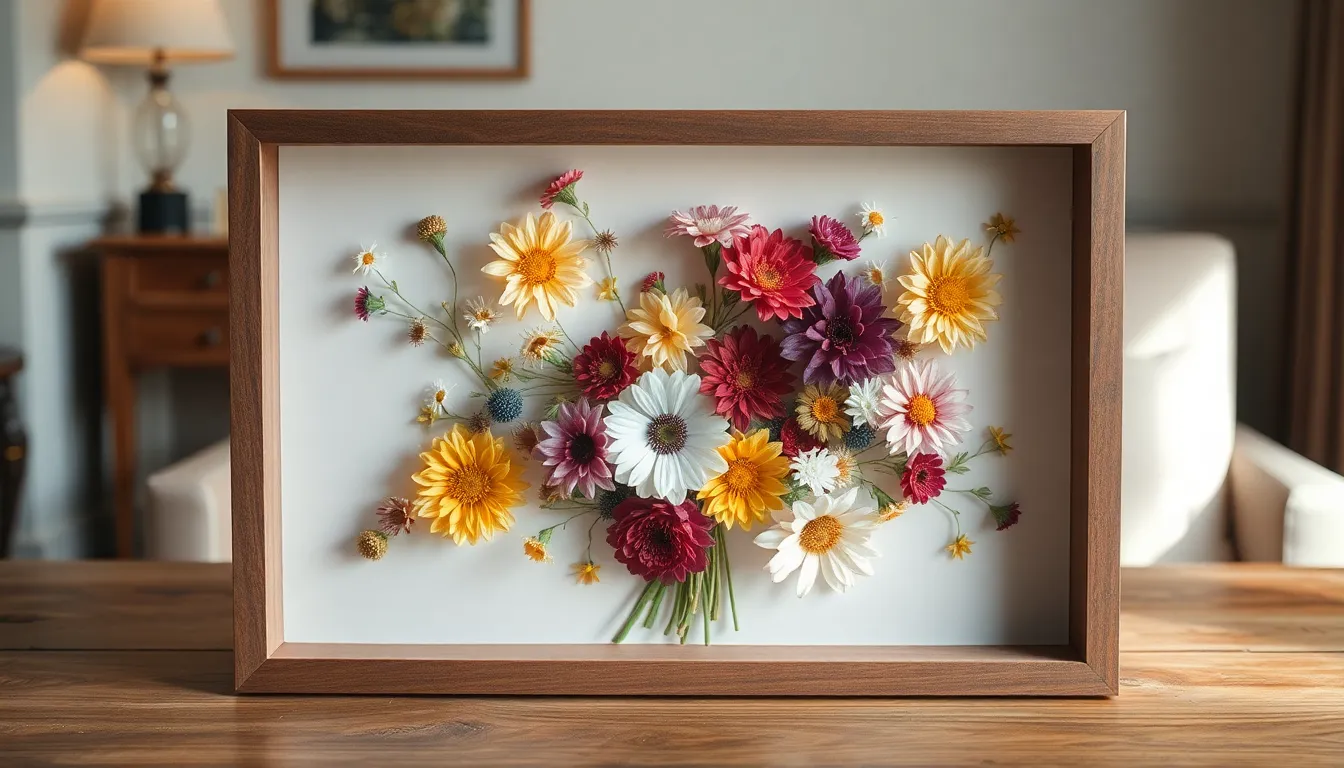
Freeze-drying stands out as the most advanced preservation method, removing moisture through flash-freezing to maintain original shape and color perfectly. This technique delivers exceptional results that make your wedding flowers look nearly identical to their fresh state.
Professional Freeze-Drying Services
Professional florists offer specialized freeze-drying services that require six to eight weeks to complete the preservation process. We recommend booking these services immediately after your wedding since professionals need fresh flowers to achieve optimal results. Most florists will guide you through flower preparation and explain the timeline for your exact blooms.
This method costs more than other preservation techniques, but the investment delivers museum-quality results. Your freeze-dried flowers retain their natural texture, vibrant colors, and three-dimensional structure perfectly. Professional services use specialized equipment that maintains consistent temperature and pressure throughout the process.
DIY Home Freezing Techniques
Home freezing offers a budget-friendly alternative, though it won’t achieve professional-level results. We suggest placing your flowers in airtight containers or ziplock bags before storing them in your freezer. Remove as much air as possible from the containers to prevent ice crystal formation.
This DIY method works best for smaller flower arrangements and individual blooms rather than full bouquets. Expect some color fading and texture changes compared to professional freeze-drying services. The process takes several weeks, and results vary depending on flower type and moisture content.
Long-Term Storage Answers
Shadow box frames provide the ideal display option for freeze-dried flowers, protecting them from dust, light, and humidity damage. We recommend UV-resistant glass to prevent color fading over time. These frames showcase your preserved blooms beautifully while maintaining their condition for decades.
Vases and terrariums work perfectly for wax-dipped or resin-treated flowers, adding decorative appeal to any room. Choose containers with tight-fitting lids to minimize air exposure and moisture infiltration. Glass options allow full visibility while providing necessary protection.
Airtight containers serve as excellent storage answers for air-dried flowers, maintaining their condition between displays. Store these containers in cool, dry locations away from direct sunlight and temperature fluctuations. Label each container with preservation dates and flower types for easy identification.
Transform Wedding Flowers Into Resin Keepsakes
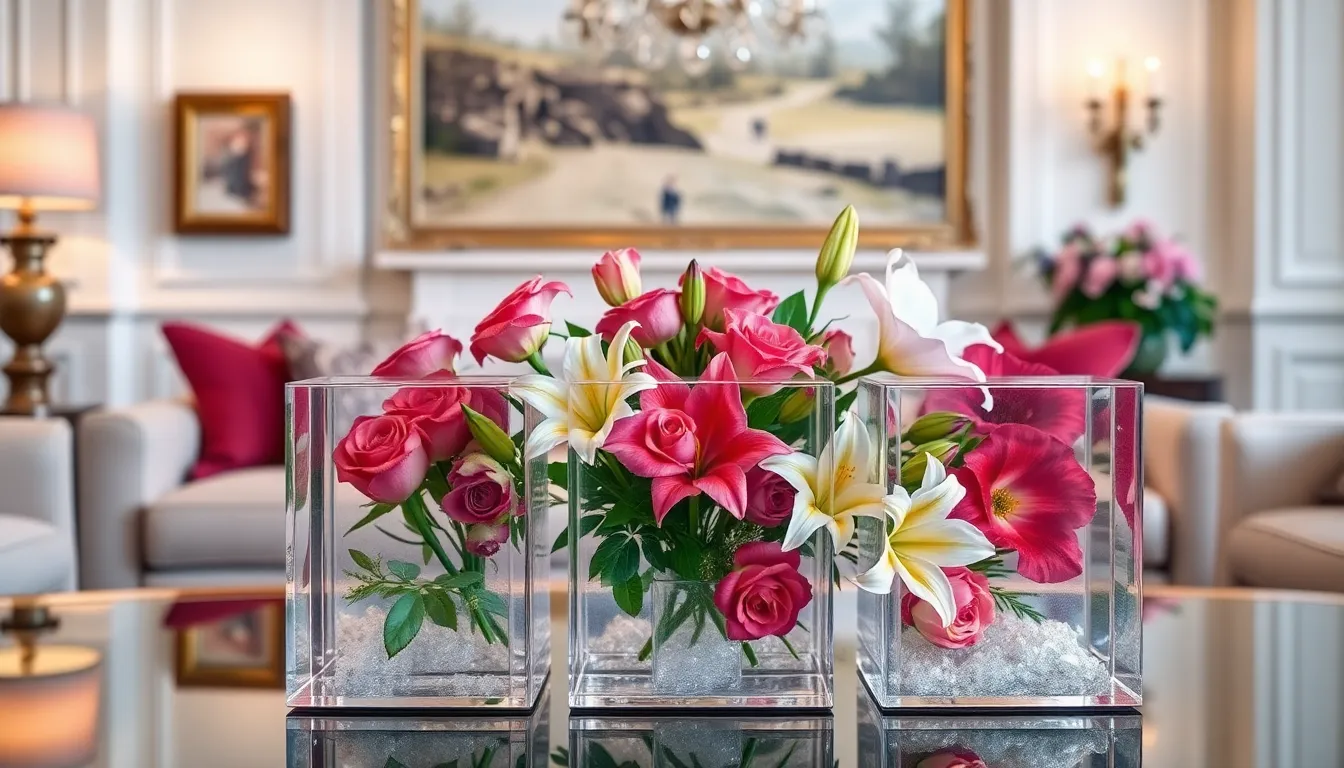
Resin preservation offers couples a modern approach to capturing their wedding flowers in crystal-clear displays that last indefinitely. This innovative technique encapsulates blooms in epoxy resin, creating stunning keepsakes that maintain their original colors and shapes for years to come.
Epoxy Resin Jewelry Making
Creating wearable keepsakes from your wedding flowers transforms special memories into daily reminders of your big day. We recommend selecting individual petals or small flower heads that’ll fit comfortably within jewelry molds without overwhelming the design.
Essential steps for jewelry creation:
- Choose fresh, unblemished petals immediately after your ceremony
- Dry flowers using silica gel for 24-48 hours to remove moisture
- Arrange petals carefully in silicone jewelry molds
- Pour mixed epoxy resin slowly to avoid air bubbles
- Cure according to manufacturer instructions before removing from molds
Popular jewelry options include pendants, earrings, and brooches that showcase your preserved blooms beautifully. The clear resin acts as a protective barrier while displaying your flowers in stunning detail.
Clear Resin Display Blocks
Display blocks create elegant tabletop keepsakes that showcase larger flower arrangements in three-dimensional art pieces. We suggest using deeper molds to accommodate whole flower heads or multiple layered petals for maximum visual impact.
Key considerations for display blocks:
| Block Size | Flower Capacity | Curing Time | Display Options |
|---|---|---|---|
| Small (2×2 inches) | 1-2 small blooms | 24 hours | Shelf accent |
| Medium (4×4 inches) | 3-5 flowers | 48 hours | Desk display |
| Large (6×6 inches) | Full cluster | 72 hours | Centerpiece |
These thick resin blocks work perfectly as decorative accents on shelves, mantels, or as conversation pieces on coffee tables. The substantial weight and crystal-clear finish give these keepsakes a professional, museum-quality appearance.
Resin Coaster and Paperweight Projects
Functional keepsakes combine sentiment with practicality, allowing you to incorporate wedding flowers into everyday items. We find that coasters and paperweights offer excellent ways to preserve smaller petals while creating useful household items.
Project applications include:
- Coasters featuring scattered petals in shallow round molds
- Trivets using heat-resistant resin for kitchen protection
- Paperweights combining multiple flower types in dome shapes
- Bookends incorporating larger preserved blooms in rectangular blocks
These functional pieces work exceptionally well for gift-giving to wedding party members or family members. Each item serves as a constant reminder of your special day while providing practical value in daily life.
The resin preservation process typically requires 5-7 days from start to finish, including drying time and full curing. Professional results depend on proper moisture removal and careful attention to mixing ratios for crystal-clear clarity.
Create Wedding Flower Shadow Boxes and Display Cases
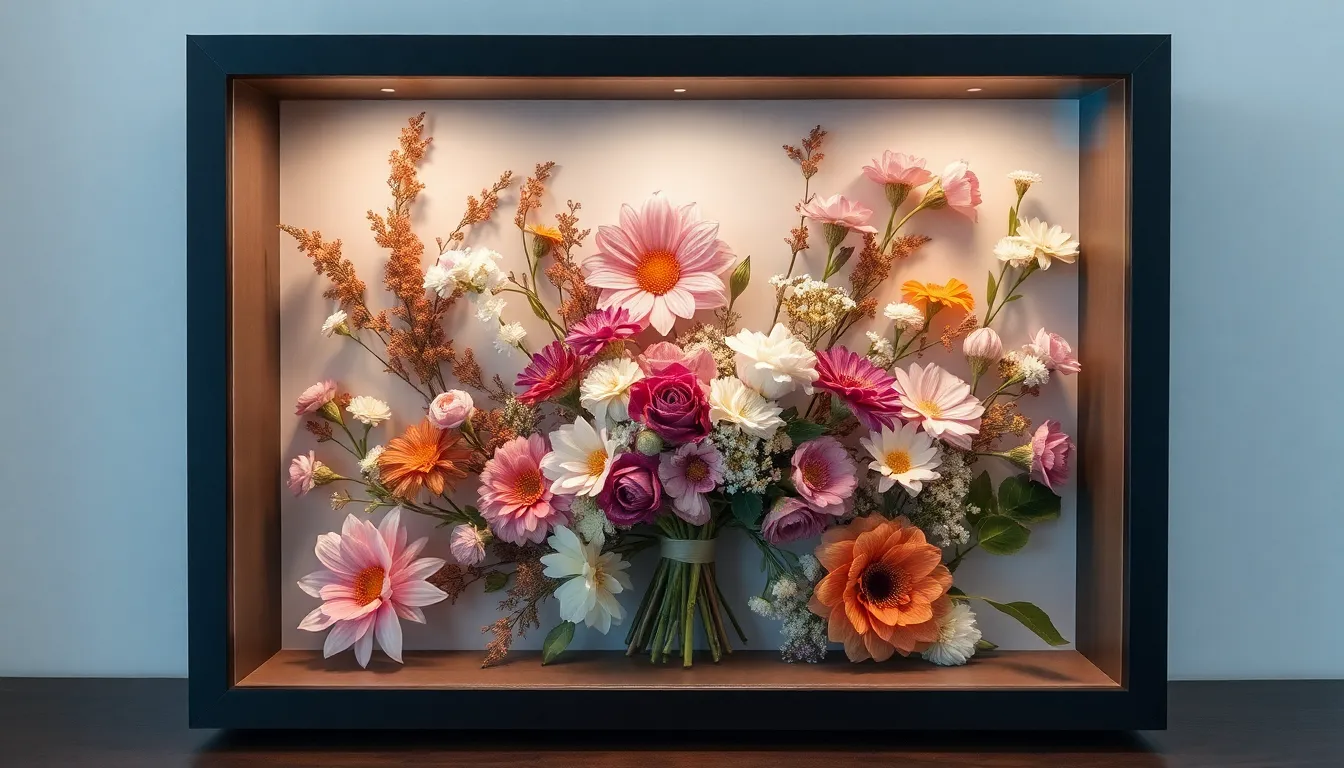
Shadow boxes and display cases offer the perfect solution for showcasing your preserved wedding flowers while protecting them from dust and damage. These three-dimensional displays transform your bouquet into a stunning keepsake that captures the full beauty of your special day.
Three-Dimensional Arrangement Ideas
Freeze-dried flowers work exceptionally well in shadow boxes since they retain their original shape and vibrant colors for years. We recommend arranging these professionally preserved blooms in their natural form within the display case to create a realistic presentation that mirrors your wedding day bouquet.
Wax-dipped flowers provide an elegant alternative with their subtle sheen and preserved structure lasting several months. These flowers maintain their three-dimensional appearance while adding a sophisticated finish that catches light beautifully in display cases.
Air-dried flowers create rustic charm when arranged in shadow boxes, though their colors may appear more muted than fresh blooms. We suggest grouping these flowers by color or type to create visual impact even though the dulled tones.
Terrarium-style arrangements offer modern appeal by housing your preserved flowers in glass containers with decorative elements like moss or small stones. These enclosed displays protect the flowers while creating an artistic focal point for any room.
Adding Personal Mementos and Photos
Wedding photographs enhance the emotional impact of your flower display by creating a multi-dimensional memory collage. We recommend including 2-3 small photos from your ceremony or reception alongside the preserved blooms to tell your complete love story.
Handwritten notes or vows transform shadow boxes into deeply personal keepsakes that capture both visual and emotional memories. These written elements add intimate touches that make each display unique to your relationship.
Small wedding keepsakes like ribbon pieces from your bouquet or ceremony programs create cohesive displays that celebrate multiple aspects of your special day. We suggest arranging these items thoughtfully to balance the composition without overwhelming the flowers.
Wedding rings or jewelry replicas can be incorporated into larger shadow boxes to represent your commitment alongside the floral memories. These metallic elements add elegance while reinforcing the matrimonial theme of your display.
Proper Lighting and Positioning Tips
Indirect lighting preserves flower colors while highlighting the beauty of your shadow box display. We recommend positioning your arrangement away from direct sunlight, which can fade even the most carefully preserved blooms over time.
Soft LED lights create dramatic effects without generating heat that could damage your preserved flowers. These energy-efficient options allow you to showcase your display while maintaining stable environmental conditions.
Eye-level positioning maximizes visual impact and makes your shadow box a natural conversation piece in any room. We suggest mounting displays at approximately 60 inches from the floor for optimal viewing angles.
Climate-controlled rooms ensure longevity by maintaining stable temperature and humidity levels around your preserved flowers. Areas with consistent conditions between 65-75°F and low humidity help prevent deterioration of your wedding flower displays.
Make Potpourri and Sachets From Your Wedding Blooms
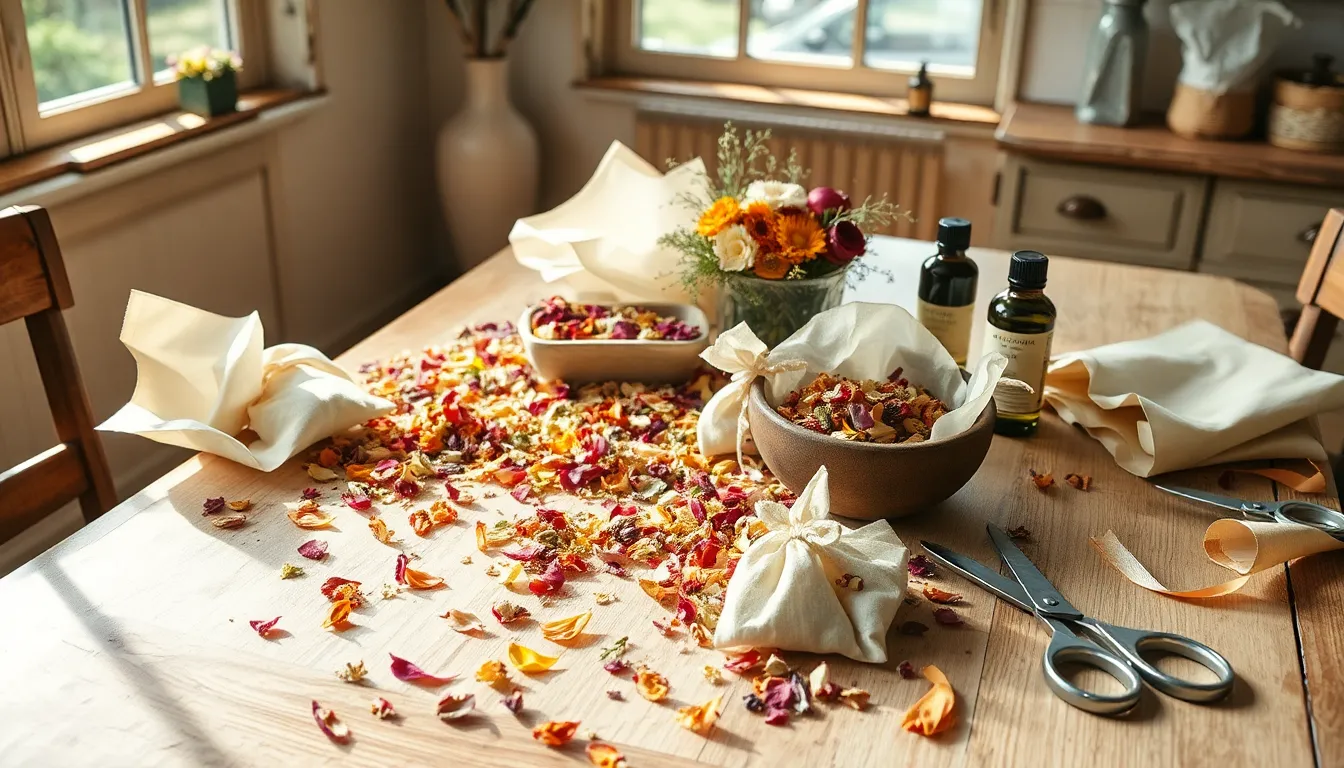
Transform your wedding flowers into fragrant home accents that’ll fill your space with romantic memories for years to come. These aromatherapy keepsakes offer a practical way to preserve your special day while creating beautiful, functional décor.
Drying Petals for Fragrant Potpourri
Select the freshest petals from your wedding bouquet immediately after the ceremony for optimal results. Spread them in a single layer on parchment paper, ensuring they don’t overlap or touch each other. Choose a dry, dark area with good ventilation like an attic, spare room, or large closet for the drying process.
Stir the petals gently every few days to promote even dehydration and prevent clumping. This careful attention helps maintain their vibrant colors and natural fragrance throughout the two to three week drying period. Monitor progress by checking if petals feel papery and crisp to the touch.
Store completely dried petals in airtight containers until you’re ready to create your potpourri blend. Label containers with flower types and drying dates to track freshness and mixing options later.
Scented Sachet Creation Process
Combine your dried wedding petals with complementary botanicals like lavender buds, dried rosebuds, or chamomile flowers for enhanced fragrance. Mix different flower types in small batches to test scent combinations before creating larger quantities. Choose natural fabrics such as cotton, linen, or muslin for your sachet bags to allow proper air circulation.
Cut fabric into 4×4 inch squares for standard sized sachets that fit perfectly in drawers and closets. Fill each bag with approximately two tablespoons of your dried flower mixture, leaving room for the petals to move freely. Gather the fabric corners and secure tightly with ribbon, twine, or decorative thread.
Create gift sets by making multiple sachets in coordinating fabrics for bridesmaids or family members. These personalized keepsakes make meaningful thank you gifts that share your wedding day memories with loved ones.
Essential Oil Enhancement Techniques
Add 3 to 5 drops of essential oil to your dried petals before filling sachets to intensify or customize the fragrance profile. Popular wedding appropriate scents include rose, lavender, sandalwood, and bergamot oils that complement most flower combinations. Mix the oil gently with a wooden spoon to distribute evenly without crushing delicate petals.
Allow the enhanced mixture to rest for 24 hours before assembling sachets so the petals can fully absorb the oils. This resting period ensures even scent distribution and prevents oil staining on fabrics. Store your enhanced potpourri in sealed containers between uses to maintain potency.
Refresh fading sachets by adding one or two drops of essential oil directly to the fabric exterior every few months. This simple maintenance technique extends the life of your wedding flower keepsakes and keeps the romantic fragrance alive in your home.
| Preservation Step | Timeline | Materials Needed |
|---|---|---|
| Petal Drying | 2-3 weeks | Parchment paper, dark ventilated space |
| Potpourri Creation | 1 day | Dried petals, complementary botanicals |
| Sachet Assembly | 30 minutes per sachet | Natural fabric, ribbon, filling |
| Essential Oil Enhancement | 24 hour rest period | Essential oils, mixing tools |
Design Wedding Flower Bookmarks and Paper Crafts
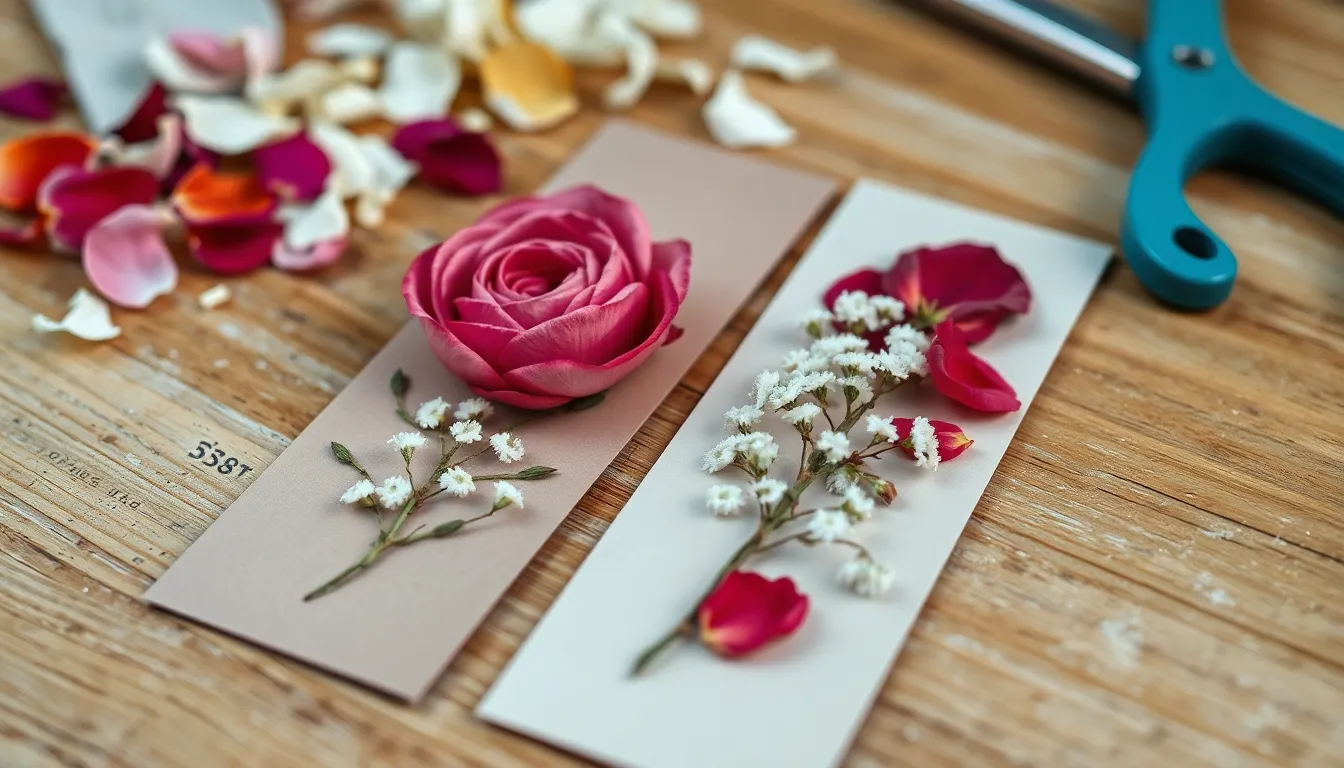
Transform your preserved wedding flowers into practical keepsakes that you’ll treasure every day. Creating bookmarks and paper crafts from your wedding flowers offers a unique way to keep those precious memories close at hand.
Laminated Flower Bookmark Ideas
Laminated flower bookmarks preserve your wedding flowers between protective sheets that maintain their beauty for years. We recommend selecting pressed flowers that have been dried for at least two weeks to ensure they won’t release moisture inside the lamination.
Place your pressed flowers between two pieces of cardstock or decorative paper, then seal them with a laminating machine or laminating pouches. The lamination process creates a waterproof barrier that protects your flowers from damage while allowing their natural beauty to shine through.
Design multiple bookmarks using different flower combinations from your bouquet, such as roses with baby’s breath or individual petals arranged in artistic patterns. Each bookmark becomes a unique piece that captures a different aspect of your wedding day florals.
Handmade Paper Incorporation Methods
Handmade paper projects allow you to integrate dried flower petals directly into the paper fibers for a textured, natural appearance. Start by tearing your dried wedding flowers into small pieces and mixing them with pulped paper in a blender with water.
Pour the flower paper mixture onto a screen or mold, then press out excess water using towels or a paper press. The dried flowers create beautiful texture and color variations throughout the handmade paper, giving each sheet a distinctive character.
Use your flower embedded paper to create custom stationery, thank you cards, or even a wedding journal where you can record memories from your special day. The embedded flowers add depth and visual interest while connecting each piece to your wedding celebration.
Greeting Card and Stationery Projects
Greeting cards featuring preserved wedding flowers make meaningful gifts for family members and friends who shared your special day. Attach pressed flowers to cardstock using acid free glue or double sided tape to prevent yellowing over time.
Create thank you cards by arranging small flower pieces in elegant patterns on quality cardstock, then add your personal message inside. These handcrafted cards show recipients how much their presence at your wedding meant to you.
Design custom stationery sets by incorporating your preserved flowers into letterhead, envelopes, and note cards. The flowers serve as a beautiful border or accent element that transforms ordinary stationery into personalized keepsakes that reflect your wedding’s unique style and color palette.
Commission Professional Wedding Flower Preservation Services
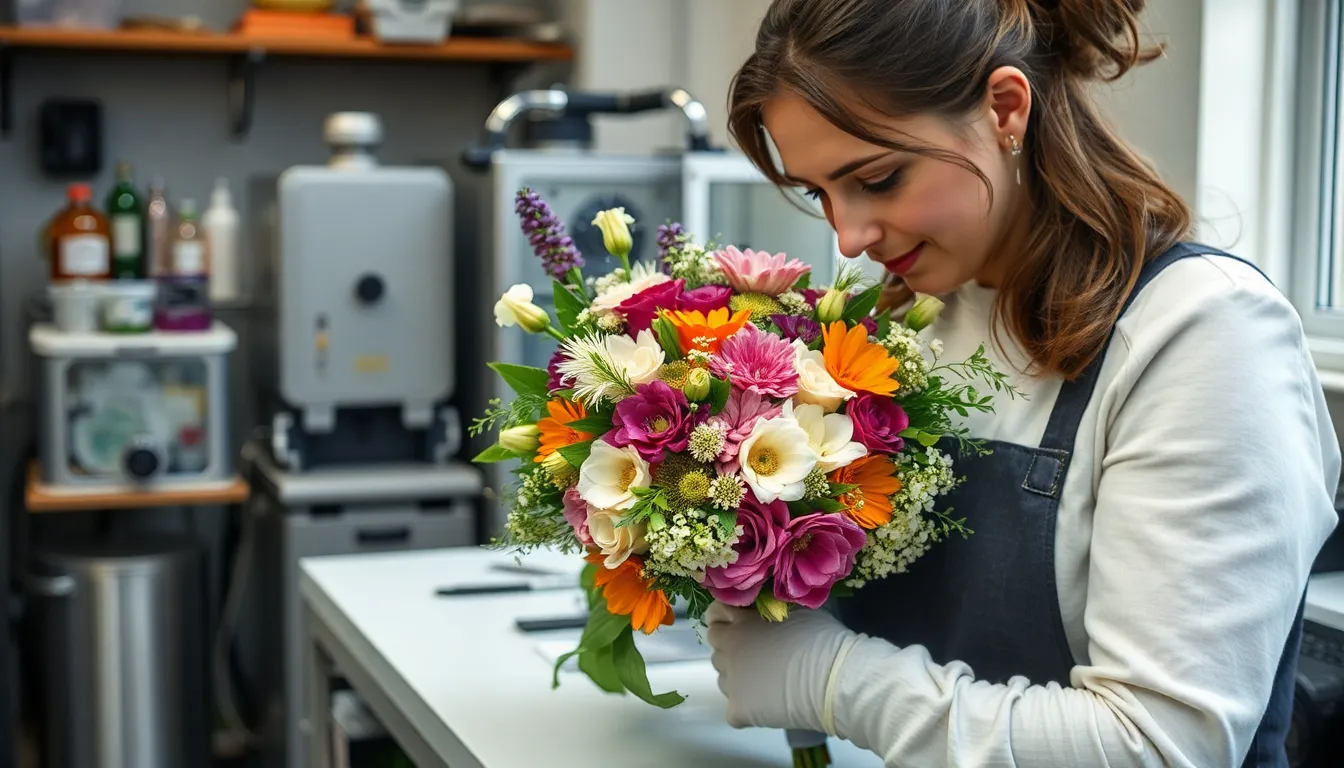
Professional preservation services offer expertise and specialized equipment that can transform your wedding flowers into museum quality keepsakes. We recommend exploring these options when you want the most sophisticated preservation results.
Choosing Qualified Preservation Specialists
Experience matters when selecting a preservation specialist for your wedding flowers. Look for professionals who maintain portfolios showcasing successful preservation projects and demonstrate expertise in handling delicate blooms. Qualified specialists should guide you through the entire preparation and preservation process while treating your bouquet with exceptional care.
Specialization areas vary among preservation professionals, so we suggest researching their exact methods and techniques. Companies like Infinity Bouquet focus exclusively on freeze drying services, which helps ensure they’ve perfected their create. Ask potential specialists about their experience with your exact flower types and preservation method preferences.
Portfolio reviews provide valuable insights into a specialist’s work quality and style. Request examples of previous projects that match your flower types and desired preservation method. Professional specialists should readily share their work and explain their processes in detail.
Understanding Different Service Options
Freeze drying stands as the most advanced preservation method available through professional services. This technique removes moisture from flowers before flash freezing them, maintaining their original shape and vibrant colors. The process requires specialized equipment and typically takes six to eight weeks to complete.
Wax dipping creates visually stunning results by preserving flower color and shape while adding an attractive sheen. This method works well for immediate visual impact, though it serves as a more temporary preservation solution compared to other techniques.
Resin preservation encases your flowers in durable, crystal clear material that creates long lasting keepsakes. Professional resin services can create various display options, from jewelry pieces to decorative blocks that showcase your blooms permanently.
Air drying services offer a simpler approach where flowers are pressed using heavy objects to flatten them completely. This traditional method works well for creating pressed flower art and framed displays.
Cost Considerations and Timeline Planning
| Service Method | Cost Level | Timeline Required | Advance Booking |
|---|---|---|---|
| Freeze Drying | High | 6-8 weeks | Required |
| Wax Dipping | Low | Few days | Optional |
| Resin Preservation | Medium-High | Several weeks | Required |
| Air Drying | Lowest | 2 weeks | Optional |
Freeze drying represents one of the more expensive preservation options due to specialized equipment requirements and extended processing time. Book these services immediately after your wedding to secure your spot, as many specialists have limited capacity.
Wax dipping costs significantly less than freeze drying but offers shorter lasting results. Complete this process within a few days of your wedding for optimal flower condition and color retention.
Resin preservation falls into the medium to high cost range but delivers permanent results that justify the investment. Plan several weeks in advance for this service, as the curing process requires adequate time for proper completion.
Air drying provides the most budget friendly option while still delivering professional quality results. This method can begin immediately after your wedding and typically completes within two weeks.
Conclusion
Your wedding flowers don’t have to fade into memory when the celebration ends. With so many preservation options available we can transform these precious blooms into lasting treasures that capture the magic of your special day.
Whether you choose DIY methods like pressing and air-drying or invest in professional services like freeze-drying and resin preservation each technique offers its own unique charm. The key is selecting the method that best fits your style budget and timeline.
These preserved flowers become more than just decorations – they’re tangible reminders of one of life’s most beautiful moments. From elegant shadow boxes to delicate jewelry pieces your wedding bouquet can continue bringing joy for years to come.
Frequently Asked Questions
What is the best method for preserving wedding bouquet flowers?
Freeze-drying is considered the most advanced and effective preservation method, maintaining the flowers’ natural shape, color, and texture. However, it requires professional services and takes 6-8 weeks. For DIY options, flower pressing and air-drying are popular alternatives that can be done at home immediately after the ceremony.
How long does it take to preserve wedding flowers professionally?
Professional preservation timelines vary by method. Freeze-drying typically takes 6-8 weeks, while other professional services like wax dipping or resin preservation usually require 2-4 weeks. Air-drying can be completed in 1-2 weeks, making it the quickest professional option available.
Can I preserve my wedding bouquet myself at home?
Yes, several DIY methods are available including traditional flower pressing, microwave pressing, air-drying, and silica gel drying. These methods can be started immediately after your ceremony and don’t require professional equipment. However, results may vary compared to professional services.
What can I create with my preserved wedding flowers?
Preserved wedding flowers can be transformed into various keepsakes including wall art, jewelry, shadow boxes, potpourri, sachets, bookmarks, and paper crafts. You can also create functional items like resin coasters or decorative home décor pieces that keep your wedding memories alive.
How much does professional wedding flower preservation cost?
Costs vary depending on the preservation method and service provider. Freeze-drying is typically the most expensive option, while air-drying and pressing services are more budget-friendly. It’s recommended to research qualified specialists and compare their portfolios, experience, and pricing before making a decision.
When should I start preserving my wedding bouquet?
Start preserving your wedding bouquet immediately after the ceremony for best results. Fresh flowers preserve better than wilted ones. If using professional services, contact them before your wedding day to arrange pickup or delivery schedules, as many preservation methods work best with the freshest possible flowers.

